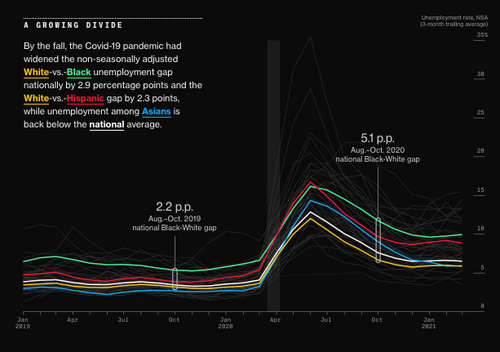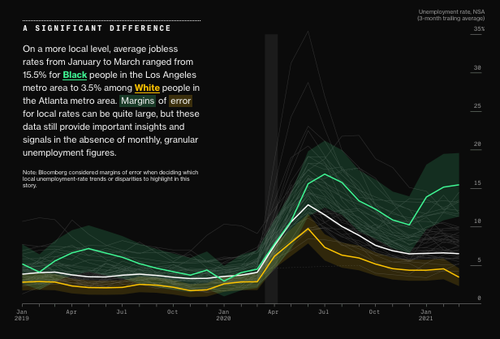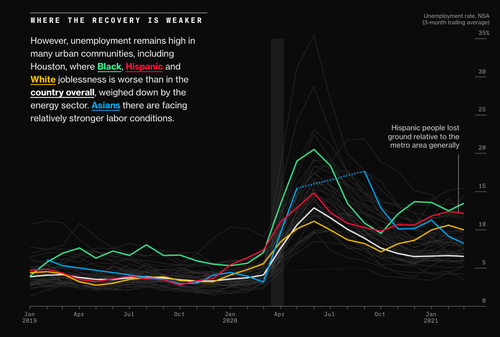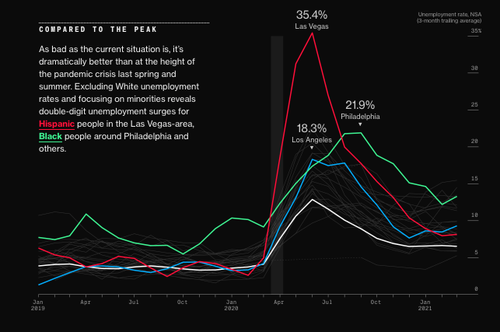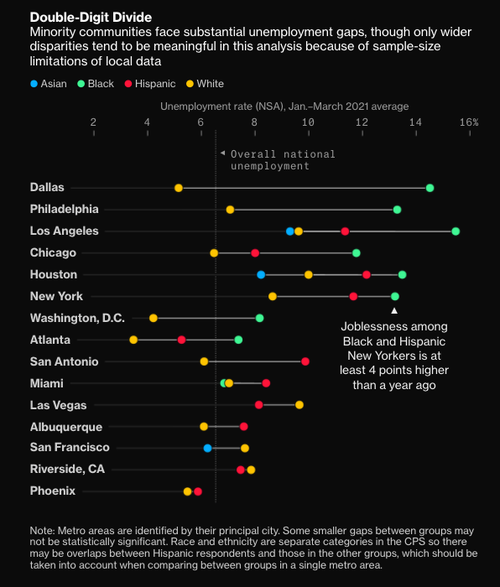Uneven Recovery Leaves Working-Poor Communities In The Dust
The US economy is fragmented more than ever. Millions of Americans continue to suffer job loss and housing and food inequities. At the same time, 650 billionaires in the US saw their net worth increase by more than $1 trillion since the pandemic began. A Bloomberg analysis provides a deep dive into the unevenness of the recovery in a dozen cities.
To capture the multi-speed track recovery for different races, social classes, and various metro areas, Bloomberg used unemployment data from a monthly Current Population Survey of approximately 60,000 households via the Bureau of Labor Statistics and the US Census Bureau.
They found the recovery is patchy geographically:
“For Asian Americans in San Francisco and Los Angeles, low tourism and high housing costs are weighing on their rebound, while Latinos in Phoenix have benefited from a strong construction sector.”
Meanwhile, the Federal Reserve and the White House have vowed to continue unprecedented monetary and fiscal accommodations until employment metrics improve, such as Black national unemployment, wage growth for working-poor, and labor force participation for those without college degrees.
Janelle Jones, the top economist at the Labor Department, recently said there “no economic recovery can be complete if some communities are left behind.” But after trillions of dollars of monetary and fiscal injections, the recovery remains uneven:
Bloomberg found the socio-economic collapse during the virus pandemic widened the non-seasonally adjusted White-vs.-Black unemployment gap nationally by 2.9 percentage points and the White-vs.-Hispanic gap by 2.3 points. In contrast, unemployment among Asians reverted to normal levels.
On a more microscopic level, average jobless rates between January and March were 15.5% for Black people in Los Angeles and 3.5% for White people in Atlanta.
Bloomberg pointed out Hispanic workers in Phoenix had better labor conditions than their peers nationally because service-related jobs were hiring more.
For Blacks, Hispanic, and Whites in Houston, joblessness across the board was much worse than the national average, primarily because of the industry-wide downturn in oil and gas. On the other hand, Asians had the best labor conditions.
Focusing on minorities, Black and Hispanic people in Las Vegas, Philadelphia, and Los Angeles face double-digit unemployment numbers.
“Still, for more than half of minority groups, local unemployment rates have not fully recovered to March 2020 levels, when stay-at-home orders were first enacted, while some gaps have widened,” Bloomberg said.
Combining the data above with other regional data such as home prices, job listings and small business loans from the Paycheck Protection Program, Bloomberg dives even further to show what minority metro areas have been left behind in the ‘frankenstein’ recovery (otherwise known as the “K-shaped” recover) produced by government and central bank.
What’s clear is that government nor the central bank can demonstrate effective policies to lift all participants. One thing is sure, the billionaires got richer, and the bottom 90% of Americans got poorer.
Tyler Durden
Sun, 05/09/2021 – 22:00
via ZeroHedge News https://ift.tt/2RCPm6P Tyler Durden
